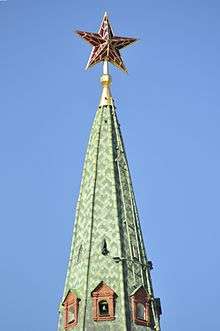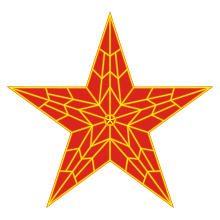Kremlin stars
The Kremlin stars (Russian: Кремлёвские звёзды) are the pentagonal luminescent ruby stars, installed in the 1930s on five towers of the Moscow Kremlin, replacing gilded eagles that had symbolized Imperial Russia.
Installation

The first Kremlin star was installed on top of the Spasskaya Tower on October 25, 1935. During the next week, another three stars were installed on the Troitskaya, Nikolskaya, and Borovitskaya towers. These stars replaced huge copper two-headed eagles, installed in pre-revolutionary times, which were a part of the Coat of Arms of Imperial Russia.
The body of each star was made of stainless steel and covered with copper plating. The Kremlin stars were decorated with a hammer and sickle on both sides, made of semi-precious stones from the Ural mountains. The installation of the first Kremlin stars did not meet the designer's expectations since the surfaces of the semi-precious stones lost their luster and required re-faceting. In 1937, these stars were replaced with new ones made of ruby glass, in time for the 20th anniversary of the October Revolution. One more star was also installed on the Vodovzvodnaya tower.
Characteristics of the stars

The size and the form of each of the five stars were defined proceeding from the height and architectural features of each corresponding tower. The distance between the end points of beams of the star installed on the Vodovzvodnaya tower equals 3 metres (9.8 ft), Borovitskaya tower – 3.2 metres (10 ft), Troitskaya tower – 3.5 metres (11 ft), and Nikolskaya and Spasskaya towers – 3.75 metres (12.3 ft). The bearing construction of each of the Kremlin stars is made of stainless steel and represents a spatial pentagonal star, the points of which have the form of a tetrahedral pyramid. The durability and rigidity of the construction was designed to withstand the maximum pressure of a hurricane wind equaling 200 kgf per square meter (2 kPa). Despite the considerable mass of each star (approximately 1 tonne (0.98 long tons; 1.1 short tons)), they revolve pretty easily as the wind changes its direction. Because of its form, each star always positions itself with its frontal side against the wind. The Kremlin stars are illuminated from the inside by filament lamps so that they could be seen against the sky. Even distribution of light inside the stars is ensured by the refractors, which consist of prismatic glass plates. The power of these lamps (3.7 kW in the stars of the Vodovzvodnaya and Borovitskaya towers and 5 kW in the remaining three) ensures good visibility of the stars day and night. The lamps have a luminous efficacy of 22 lm/W. The 5 kW lamps are 383 millimetres (15.1 in) in length, the diameter of their retorts is 177 millimetres (7.0 in). Each lamp produces a great deal of heat; hence, each star has to be cooled. For this purpose, each tower is equipped with two fans aimed at the star.
When the stars were being covered with glass, the experts had to take into consideration the fact that the stars had to shine brightly during the night and keep their ruby red color during the day so that the electrical filament in the lamps remained invisible. Also, the experts had to consider the fact that the red glass illuminated from the outside by the sun appears almost black. In 1946, they installed a combination of different types of glass for the stars, namely, ruby red and milk-white glass with a layer of transparent crystal glass between them. The milk-white glass disperses the light of the lamps and reflects most of the daytime light at the same time, softening the darkness of the ruby glass during the day. In order to achieve more contrast and emphasize the beams of the stars, they installed the ruby glass in different shades, which absorbs only the red rays with a wavelength of no more than 620 nanometres (2.4×10−5 in).The thickness of the glass in the stars is 6 to 8 millimetres (0.24 to 0.31 in). The area of a star covered with glass equals 6 square metres (65 sq ft). The special three-layered glass sheets (milky white, crystal clear, and ruby) were manufactured by the Gus-Khrustalny glass factory. The ruby layer of the sheets is actually colored by adding colloidal gold to the glass.
Machinery that services the Kremlin stars are located inside the towers. Special lifting devices allow for periodic cleaning of the stars inside and out, removing dust and soot. The machines can replace burnt-out lamps within 30-35 minutes. Experts in a special control room observe the work of the machinery.
References
| Wikimedia Commons has media related to Kremlin stars. |
- Content of this page in part derives from the Great Soviet Encyclopedia article on the same subject (online).
Coordinates: 55°45′9″N 37°37′17″E / 55.75250°N 37.62139°E
